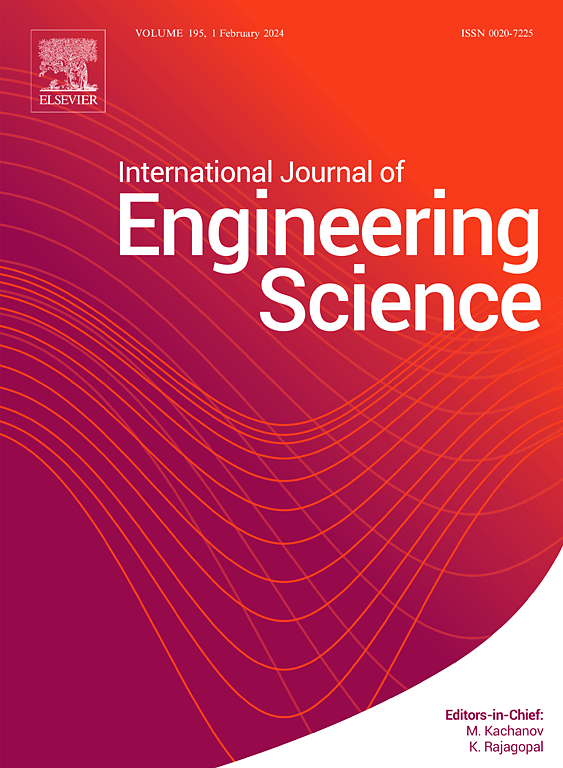Coupled chemo-mechanical constitutive equations and residual stress evolution of swelling hydrogels
IF 5.7
1区 工程技术
Q1 ENGINEERING, MULTIDISCIPLINARY
International Journal of Engineering Science
Pub Date : 2025-09-27
DOI:10.1016/j.ijengsci.2025.104390
引用次数: 0
Abstract
Hydrogels are cross-linked polymeric materials capable of undergoing large deformation in response to external stimuli, such as chemical gradients and mechanical loading. This article presents a coupled chemo-mechanical model of hydrogel undergoing substantial swelling. A multiplicative decomposition-based framework is adopted to represent simultaneous swelling and mechanical deformation in a consistent thermodynamic way. A nonlinear modified hyperelastic Yeoh–Fleming model is considered for the fully swollen hydrogel to describe the strain energy of the polymer network and is calibrated from the available experiments. After calibrating the model using uniaxial stretching for different volume fractions of the polymer network, the model is then benchmarked with equi-biaxial and pure shear responses. The model calibration at different polymer network volume fractions also allows evolution of the Yeoh–Fleming model parameters with polymer network concentration. Finally, we combine the free energy of mixing of solvent and polymer network and the strain energy of polymer network to solve a coupled boundary value problem (BVP) of free swelling. The solution predicts free swelling of hydrogel and the evolution of residual stresses induced by a slow diffusion phenomenon. The numerical results presented here may provide guidance for significant applications of hydrogels in soft robotics, drug delivery and biomedical systems.
溶胀水凝胶的化学-力学耦合本构方程及残余应力演化
水凝胶是一种交联聚合物材料,能够在外部刺激(如化学梯度和机械载荷)下发生大变形。本文提出了水凝胶剧烈膨胀的化学-力学耦合模型。采用基于乘法分解的框架,以一致的热力学方式表示膨胀和机械变形同时发生。考虑了完全膨胀水凝胶的非线性修正超弹性yeo - fleming模型来描述聚合物网络的应变能,并根据现有的实验进行了校准。在对聚合物网络的不同体积分数使用单轴拉伸校准模型后,然后对模型进行等双轴和纯剪切响应的基准测试。在不同聚合物网络体积分数下的模型校准也允许yeo - fleming模型参数随聚合物网络浓度的变化。最后,结合溶剂与聚合物网络混合的自由能和聚合物网络的应变能,求解了自由膨胀的耦合边值问题。该解决方案预测了水凝胶的自由膨胀和由缓慢扩散现象引起的残余应力的演变。本文给出的数值结果可能为水凝胶在软机器人、药物输送和生物医学系统中的重要应用提供指导。
本文章由计算机程序翻译,如有差异,请以英文原文为准。
求助全文
约1分钟内获得全文
求助全文
来源期刊

International Journal of Engineering Science
工程技术-工程:综合
CiteScore
11.80
自引率
16.70%
发文量
86
审稿时长
45 days
期刊介绍:
The International Journal of Engineering Science is not limited to a specific aspect of science and engineering but is instead devoted to a wide range of subfields in the engineering sciences. While it encourages a broad spectrum of contribution in the engineering sciences, its core interest lies in issues concerning material modeling and response. Articles of interdisciplinary nature are particularly welcome.
The primary goal of the new editors is to maintain high quality of publications. There will be a commitment to expediting the time taken for the publication of the papers. The articles that are sent for reviews will have names of the authors deleted with a view towards enhancing the objectivity and fairness of the review process.
Articles that are devoted to the purely mathematical aspects without a discussion of the physical implications of the results or the consideration of specific examples are discouraged. Articles concerning material science should not be limited merely to a description and recording of observations but should contain theoretical or quantitative discussion of the results.
 求助内容:
求助内容: 应助结果提醒方式:
应助结果提醒方式:


